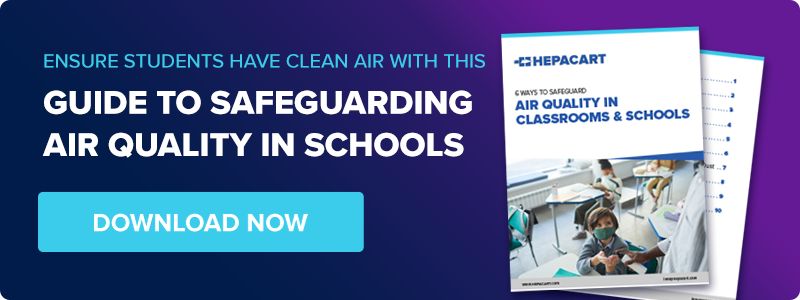Share this
Don’t Let the Effects of Poor Air Quality Affect Your School
by HEPACART on Apr 01, 2024

Anyone who has spent time around school-aged children can tell you — coughing and sneezing are inevitable. With so many kids in one place all day, allergens and germs can run rampant if left unchecked. Even when classrooms are cleaned and sanitized regularly, airborne pollutants and dust can irritate students and teachers who spend hours indoors each day.
Even though we can’t always see the harmful particles in the air around our classrooms, poor Indoor Air Quality, or IAQ, can contribute to how often students and teachers deal with sickness, allergies, and irritation at school. For students, these side effects of poor air quality can mean days spent at home to recover from a cold or allergy attack, meaning missed classroom time and makeup work. For teachers, the hassle of finding a substitute can make sick days even more stressful and challenging. With the right knowledge and equipment to tackle indoor air pollution, you can set your facility up for success — and fewer sick days — this school year.
The Hidden Challenge: Indoor Air Quality
Clean air might not be the first thing you think of when trying to improve school performance, but it should be. From damp classrooms to outdated heating and cooling systems, many things can make your school’s indoor air less than ideal. This isn't just about sniffles and sneezes — it's about making sure students can think clearly and get the most out of their school day without indoor air pollutants spreading sickness or causing irritation.
Breathe Easy with 3 Strategies for School Air Quality
.png?width=900&height=450&name=Blog_Classroom%20IAQ%20(1).png)
Getting started with higher levels of IAQ quality begins with a few simple fixes that can significantly improve the overall health and safety of your facility’s indoor air. Before opting for expensive equipment, start with three easy IAQ solutions.
1. Keep Humidity in Check: Aim for indoor humidity levels between 40-60%.
Drier environments can irritate the respiratory system and allow viruses to stay airborne for longer, while more humid environments can encourage the growth of mold and other harmful substances. 40-60% humidity is the safest range for indoor air to strike the right balance.
2. Consider Seasonal Allergens: Keep in mind that some times of year are more prone to poor air quality than others.
For example, spring and fall are notorious for high allergen counts in the outdoor air, while summertime can come along with wildfires that put large amounts of smoke into the air. When outdoor air is of poor quality, consider keeping windows and doors closed more often and keeping an eye on the heating and air schools are pumping around the facility.
3. Choose Safer Cleaning and Decorating Supplies: Look for products that don't give off strong smells or harmful chemicals.
Many of the products and supplies that schools use frequently are responsible for emitting Volatile Organic Compounds (VOCs) into the air. These can come from paint, plastics, building materials, and more. Consider the cleaning products and materials coming into your facility to limit exposure to VOCs.
Navigating the Crowded Classroom: Strategies for Clean Air
Schools are bustling for most of the week, which can make it much more difficult to keep the air clean. Even compared to busy offices, schools pack in a larger number of people in each room, meaning more breaths are taken and more chances for germs to spread. Not to mention that schools often have several multi-purpose rooms like cafeterias, libraries, and gyms that increase the number of touchpoints and potential sources of airborne contamination.
Tight budgets can make it tough to keep up with regular cleaning and maintenance, but ignoring air quality for long can lead to bigger problems down the line — reduced efficiency, costly repairs, unhappy parents, and negative publicity, to name a few. Ultimately, neglecting indoor air quality is bad for everyone involved and leads to higher liability and risk for the entire facility.
3 Powerful Strategies for School IAQ
Luckily, there are several strategies that you can implement in the classroom and the entire school to prioritize IAQ and keep everyone inside as safe and healthy as possible to avoid the side effects of poor air quality.
1. Know the Signs
Seek out education about how to identify problems as well as what to do in an emergency. To keep a better handle on the current IAQ in your facility at any given time, consider investing in a wireless, battery-operated monitor that can keep you updated on any potential air quality issues. While some monitors will give you a broad overview of the quality of your indoor air, others can detect signs of specific pollutants like mold spores. Depending on what your budget allows, you may want to consider different models based on your school’s concerns. Given your district’s procedures and regulations, you may have specific guidelines for what air quality cancels school or when serious interventions are needed.
2. Get Fresh Air In
When it’s safe to do so, open windows to let in outdoor air; this not only introduces a breeze and fresh air into the school, but ventilation can also reduce the concentration of airborne pollutants inside. Of course, you’ll need to consider safety and regulations when it comes to opening up your facility to the outdoor air, so be sure to consult your school’s rules beforehand.
If opening windows isn’t an option for one reason or another — potentially because of outdoor air pollution or the classroom being right on a busy road with lots of traffic, for example — your next best solution is to use air purifiers to create better airflow while also cleaning your indoor air periodically. Air purifiers offer a great alternative to fans or open windows when noise is a major concern because they are typically quiet and non-disruptive to classroom learning.
3. Clean the Air
To maximize your school’s IAQ, you can’t beat a HEPA filtration system for your facility. HEPA, or High-efficiency Particulate Air filters, are the gold standard in filtration and are proven to capture 99.97% of airborne particles down to 0.3 microns in size. This means that a majority of harmful pollutants are captured and locked away in the HEPA filter fibers, resulting in cleaner, healthier air for everyone in the facility.
Similar to an air purifier, a HEPA filter runs quietly and without disrupting classroom activities, so learning can go on uninterrupted while the air is being continuously filtered of harmful particles like germs and viruses. However, you’ll want to make sure that all doors and windows are closed in the area where you’ll run the HEPA filtration system to make sure that it can operate most efficiently.
Embrace Clean Air in Education with HEPA Filtration
.png?width=900&height=450&name=Blog_Classroom%20IAQ%20(2).png)
Focusing on clean air in your school means more time spent safely learning and growing rather than dealing with the aftermath of poor IAQ in your classrooms. One of the best ways to prioritize clean air and set your students and teachers up for success is with HEPA-powered air purifiers to reduce indoor air pollution. Fewer school absences, fewer school nurse visits, and fewer substitute teachers are a few of the many reasons why a great IAQ is helpful for your school. Most importantly, however, with healthy air in your classrooms, teachers and students alike can spend less time coughing and more time learning together.
Ready to make a change? Grab our guide on improving indoor air quality in schools. It's full of tips and tricks to help you get started with bringing cleaner air to your classrooms.

